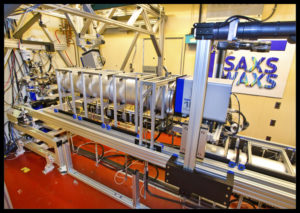Nanogeometry

X-ray beamline at Lawrence Berkeley National Laboratory’s (LBNL) Advanced Light Source. (Image: LBNL.)
Software that adapts a valuable light-scattering geometry to work with the world’s fastest supercomputers will give materials scientists a better picture of thin films that could be used to develop numerous energy-relevant nanodevices.
Scattering geometry describes the path of an X-ray beam off a sample – typically off the target’s surface at a 90-degree angle. But one scattering technique, first described in 1989, helps researchers understand thin films, minuscule material structures (often at the nanoscale level) with numerous energy applications: organic photovoltaics, batteries, energy-storage systems, fuels and carbon capture and sequestration systems.
At Lawrence Berkeley National Laboratory’s Advanced Light Source (ALS), a process called Grazing Incidence Small Angle X-ray Scattering (GISAXS) describes the way X-rays interact with a thin-film sample as they barely graze it. Analyzing the scattered light provides information about the material. In GISAXS, X-ray beams hurtle from a storage ring many meters toward a thin-film sample and hit it at a very shallow angle – only 0.2 degrees (thus “grazing angles”), if you envision looking at the film almost edge-on.
In probing complex structures like these thin films, “a model definition can grow in three dimensions and as large as billions of cells” – a “computationally intensive challenge,” says Xiaoye Sherry Li, senior scientist at Berkeley Lab’s Computational Research Division.
To address that staggering data flood and better interpret the software’s output, Li’s colleague Alexander Hexemer, an ALS experimental staff scientist, and team members devoted five years to write the novel high-performance computing code HipGISAXS, developed under LBNL’s CAMERA (Center for Advanced Mathematics for Energy Research Applications). The software enables researchers to do advanced simulations on massively parallel systems that incorporate hundreds of thousands of compute cores.
Several parameters describe thin-film makeup, such as the size of molecules in the crystal structure. The technique the LBL researchers use does not easily reveal such information.
“To get the values out of the images we collect, we have to build a model of the polymer examined and simulate the experiment in the computer,” Hexemer says. “In the beginning, the simulated image does not match what we measure, and we have to change our model to better fit our data. This process of changing the parameters to match the output of the detector is called fitting. And we are applying a method called particle swarm optimization to seek and improve the model to represent the data.”
Li and Hexemer were awarded 10 million processor hours on the Oak Ridge Leadership Computing Facility’s Cray XK7 Titan supercomputer through the ASCR Leadership Computing Challenge. While on Titan, the researchers say, they enhanced the software to include inverse modeling approaches.
“We have had some favorable outcomes that should enable insights and discoveries into key materials structures at the nanoscale level,” Li says. Using a method called reverse Monte Carlo, Hexemer says, they found “if you have resources like Titan, complex simulations are feasible.” A demonstration of a fuel-cell membrane enabled “real-time feedback. That the research community can now address real-time analysis of thin films is this project’s highest achievement.”
There are 40 beamlines at ALS. Hexemer is responsible for versatile, flexible, scattering beamlines that can work with soft and hard X-rays. The process begins with the accelerator, which speeds up electrons and spins them out into a large storage ring – basically a pipe inside a concrete wall. Magnets above and below the pipe bend the electrons, which then radiate light in a variety of spectra. They emit at a point where a beamline is attached to the storage ring. Shining along the beamline, the multicolored light illuminates a monochromator, a layered or crystalline material that picks out a single wavelength.
“This multilayered monochromator picks out an X-ray wavelength of 1.23 Ångstroms (about a tenth of a nanometer),” Hexemer says. Next, the X-rays are focused, then expose the sample of interest.
“Let’s say that you have a 100-nanometer-thick polymeric film on top of a silicon wafer in the sample compartment,” he says. “The silicon wafer looks like a mirror to the X-rays. The mirror effect is a result of the small incoming angle, just like water surface can look like a mirror if you look from below. Also coming in at really small angles, the footprint of the beam with the sample is much, much longer than 100 nanometers. Suddenly, you have enough interaction with the X-rays and the film to measure films that are 100 nanometers thick and below.”
Hexemer says with new detectors in place at ALS, he and his colleagues can collect up to 300 frames per second in morphology experiments.
“Our software takes advantage of the latest algorithms developed around the world to ensure that it is fast enough and scaled enough to address very high throughput beams like ours,” he says. “It makes total sense to align ourselves with really hardcore applied mathematicians to help us accelerate our research and algorithms.”
About the Author
Tony Fitzpatrick writes about a wide variety of topics in science, technology and the environmental and agricultural sciences. His stories, articles and essays have appeared in newspapers and magazines nationwide. He is author of Signals from the Heartland.




